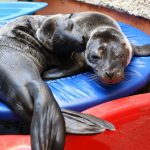SHOULD PUPS IN REHAB BE HANDLED MORE THAN NECESSARY FOR ESSENTIAL FEEDING AND MAINTENANCE?
There is a general rule amongst wildlife rehabilitation organisations that contact between the wild animal and the rehabilitator should be minimised in order to avoid problems of social imprinting on humans, dependency, or lack of fear. In many cases of seal rehabilitation, this leads to newborn seal pups being reared in isolation.
Harbour seals are a highly social species. Newborn pups are in continuous contact with their mother for the first two weeks or so after birth. On shore they suckle and lie beside her. In the water – and they may spend about half of their time in the water – they stay close beside their mother, following her, nosing her, riding on her back and playing with her. As the pup gets a little older, it starts to follow other pups and other adults, and engage in social contact with them. A HARBOUR SEAL PUP IS NORMALLY NEVER ALONE. If it is separated from its mother, it gives the distress call – a penetrating, individually distinct and directional vocalisation, which helps the mother to find it.
In rehab, therefore, it is essential that harbour seal pups have social contact. Ideally there will be more than one pup, and pups may be kept together and will give each other most of the social contact they need. However, if there is only one pup in a rehab facility, IT IS BETTER FOR THE PUP TO HAVE HUMAN CONTACT THAN TO HAVE NO SOCIAL CONTACT AT ALL. All infant mammals need appropriate tactile and other social stimulation for normal psycho-social development. We have found that our single pups have cried continually until we go and sit with the pup, play with it in the pool or, sometimes provide it with a surrogate. We have not found that this results in any lasting ‘imprinting’ on humans. Some pups seem to become less interested in human contact in any case as they approach their release (usually 5-6 weeks in our facility), we have not experienced any serious problems in releasing the pups, and there have been no recorded incidents of our pups approaching humans after release.
The question remains, however, whether rehab pups may be in danger after release through lack of fear of humans. However, it is inevitable that all rehab pups will tolerate human proximity, even if they are socially reared with other pups. They have to be approached and handled gently and sensitively several times a day when being fed, water changed, etc. Even wild harbour seal pups after weaning tolerate quite close human approach. Weaned pups in the wild may sleep so deeply that they may get left behind at a haul-out site (when the tide has gone out) and do not waken even when a human is beside them, or even flee upon wakening. However, both wild and rehab pus after release are usually amongst other seals at haul-outs, and follow other animals into the water away from human threats. We have no evidence that our rehab pups are significantly more at risk from human threats than wild pups. In our view, withholding social contact from single pups would not benefit the pup in any way. Conversely, to keep pups in isolation and withhold social contact – as some sanctuaries make a virtue of doing – is a result of misapprehension of seal behavioural ecology, and is contrary to the interests of the animals’ welfare.

